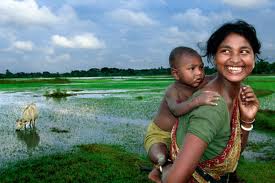(21 February 1989, Kolkata) – The original inhabitants of Bangalistan include the Rajbanshis from North Bengal; the Mahatos from Ráŕh; the Cakmas from Chattagram and Tripura; the Mahisyas from Midnapore and 24 Paraganas; the Sadgopes from Birbhum; the Namashudras from Jessore and Khulna; and the Ugra Kśatriyas from Burdwan. These original Bengalees may be called the “Játa Bengalees”.
The proof that these communities are the original Bengalees is that they are situated in numerous adjacent villages throughout the regions they inhabit. Village after village of these original inhabitants are located together. They do not populate one or two isolated villages, nor are there merely several people from these communities scattered in a few villages throughout the region. This proves the the local people were consolidated in particular areas. In contrast, the Brahmins and the Kayasthas are found in only a few villages and are few in number, thus we cannot be sure that they are the original inhabitants of Bengal. They may have come from other parts of Bengal to do some special kind of work, as priests for example, or they may have come from outside Bengal.
“Do not waste your time in dialects and sub-dialects
as this is the approach of analysis. All dialects
should merge in the main language. This is
the approach of synthesis.”
Whenever you plan any developmental programme for Bengal, you should keep the interests of the Játa Bengalees uppermost, as they are the original inhabitants and taken together comprise the majority community. If they are benefited, the whole of Bangalistan will be benefited.
The original name of the Bengali community was “Kaebarta” meaning “a community of fishermen”. They were divided into five groups – the Namashudras in the east; the Rajabangshir in the north; the Mahisyas in the south; the Sadgopes in the northern part; and the Mahatos in the west. Mahato came from “Mahatma”. These original five communities were not tribals.
In Bengal there are many small groups of people speaking non-Sanskritic languages. For example, Indo-Tibetan and several other languages. These groups are known as “tribals” – those speaking non-Sanskritic languages. The Játa Bengalees are the indigenous population of Bengal and speak a pure Sanskritic language.
Human society is one and indivisible, so Bangalistan must not go against the interests or spirit of universal humanity. This is a must. You have to see the interests of the place where you remain, but you should not go against the spirit of universal humanity. Do not waste your time in dialects and sub-dialects as this is the approach of analysis. All dialects should merge in the main language. This is the approach of synthesis
Copyright Ananda Marga Publications 2012


Useful and authentic Contents or information, my authentic website is similar to your website.